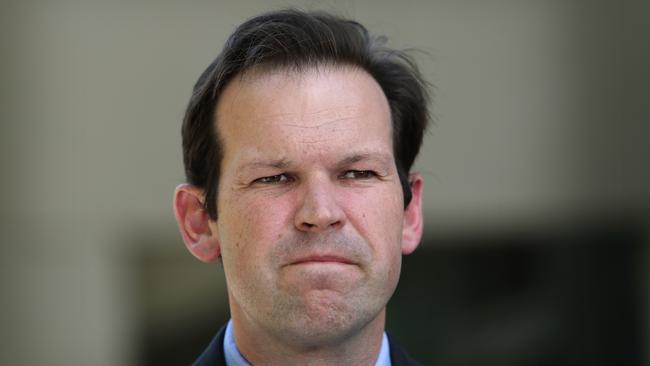Billion-dollar WA projects at risk from new EPA emission rules
Tens of billions of dollars in new resource projects will be at risk after WA’s EPA announced tough new carbon measures.

Tens of billions of dollars in new resource projects will be at risk after Western Australia’s Environmental Protection Authority announced tough new measures around carbon dioxide emissions.
The EPA, which makes recommendations to the WA government about whether major projects should proceed, revealed new requirements for companies to demonstrate how they would offset all emissions from their developments.
The new regulations will affect planned projects such as Woodside Petroleum’s $US11 billion ($15.6bn) Scarborough gas project and its $US20.5bn Browse development, as well as existing projects such as the $US34bn Wheatstone LNG plant and the $US54bn Gorgon LNG plant.
EPA chairman Tom Hatton said yesterday the tougher interpretation reflected the lack of progress being made by Australia in meeting its climate targets, arguing that current federal regulations did not go far enough.
“In our view those (federal) regulations are not going to deliver the outcomes as currently applied that are necessary for Australia to meet its international obligations under the Paris Agreement. That’s why we’re doing this,” Dr Hatton said yesterday.
He said the body was setting a “higher bar” for major projects.
“For some it will be more onerous than they may have enjoyed in the past,” Dr Hatton said.
“One of the reasons we plan to give the proponents a lot of time to consider plans is because it is onerous and puts a greater burden on transparency and planning and offsetting.”
The tougher guidelines will apply to all major projects already under assessment by the EPA, such as Scarborough and Browse, as well as any future major projects. Both Gorgon and Wheatstone will also be assessed under the new criteria given they have both been referred back to the body by the WA government with a specific request to study their emissions abatement efforts.
The reassessment of Gorgon centres on the monster project’s long-delayed efforts to capture carbon emissions from the plant and sequester them deep underground.
The sequestration project was a key part of its original environmental approvals but has so far failed to deliver amid a series of technical issues.
The tougher new guidelines add another hurdle to major developments in WA at a time when the resource-reliant economy, which is responsible for more than a third of the nation’s exports, remains sluggish.
Fresh data released this week showed a 0.3 per cent fall in WA’s gross domestic product during the December quarter.
Federal Resources Minister Matt Canavan slammed the EPA’s new position as “a homemade sledgehammer” against the WA economy.
“It would be ridiculous for Australia to impose much greater restrictions on the development of our oil and gas than exists overseas,” he said. “It would do nothing to protect the environment but it would cost thousands of jobs in Australia.”
The stricter interpretation could add substantially to the cost of new developments, with industry already up in arms about the changes.
A spokesman for Chevron said the EPA’s guidance had the potential to discourage future investment in WA gas projects, while a spokeswoman for Woodside said the changes could hurt projects that would otherwise replace dirtier sources of emissions elsewhere in the world.
“Direct and arbitrary regulation at the state level, as proposed by the EPA, appears out of step with Australia’s international targets and the associated emissions trajectory, raises further potential for conflict between regulation and jobs, and may perversely penalise investment in cleaner fuels such as natural gas which have a big role to play in global emissions reduction,” the spokeswoman said.
The EPA’s new processes could also impact on other major resources projects in the state.
Rio Tinto’s iron ore operations generated 3.2 million tonnes of carbon emissions last year, suggesting the individual Pilbara mines of it and other big iron ore miners such as BHP and Fortescue Metals Group are likely to easily exceed the 100,000 tonne per annum threshold at which offsets are now required.
Paul Everingham, the chief executive of the Chamber of Minerals and Energy in WA, said the new guidelines could stop new projects from going ahead.
“This would put at risk billions of dollars of investment; thousands of cleaner energy jobs and damage the very industry that is helping WA and the world to transition to a clean energy future,” he said.
He also warned that there was “massive potential downside” by requiring carbon offsets to be based out of Australia, noting that the WA offset market “would simply not cope” if the EPA guidelines were adopted as government policy. The EPA’s step is the latest in a series of recent emissions-linked decisions that have affected projects in Australia.
The NSW Land and Environment Court last month blocked Gloucester Resources’ proposed development of the Rocky Hill coking coal mine in part due to its forecast “scope 3 emissions” generated when its coal would be burnt to make steel.
Scope 3 emissions will also now be considered by the EPA, but Dr Hatton said the EPA would “absolutely” consider the emissions benefits of LNG projects that displaced dirtier coal-fired power.
WA Environment Minister Stephen Dawson said the government would carry out consultation on the EPA guidance but stressed that creating jobs and economic development would remain the government’s key priority.
“The McGowan government is fully supportive of our job-creating LNG industry and will listen to their views as part of our response to the EPA,” he said.
The EPA’s new stance was widely praised by green groups.
Conservation Council of WA director Piers Verstegen said previous policies had allowed some of Australia’s largest polluters to operate with no effective emissions controls.
He estimated the requirements could create about 4000 jobs in the carbon offset industry.
“While this policy does not explicitly rule out new fossil fuel developments, it is a big step forward that could make a huge contribution to controlling pollution growth while helping to drive new sustainable industries for WA,” he said.
— Additional reporting: Perry Williams



To join the conversation, please log in. Don't have an account? Register
Join the conversation, you are commenting as Logout